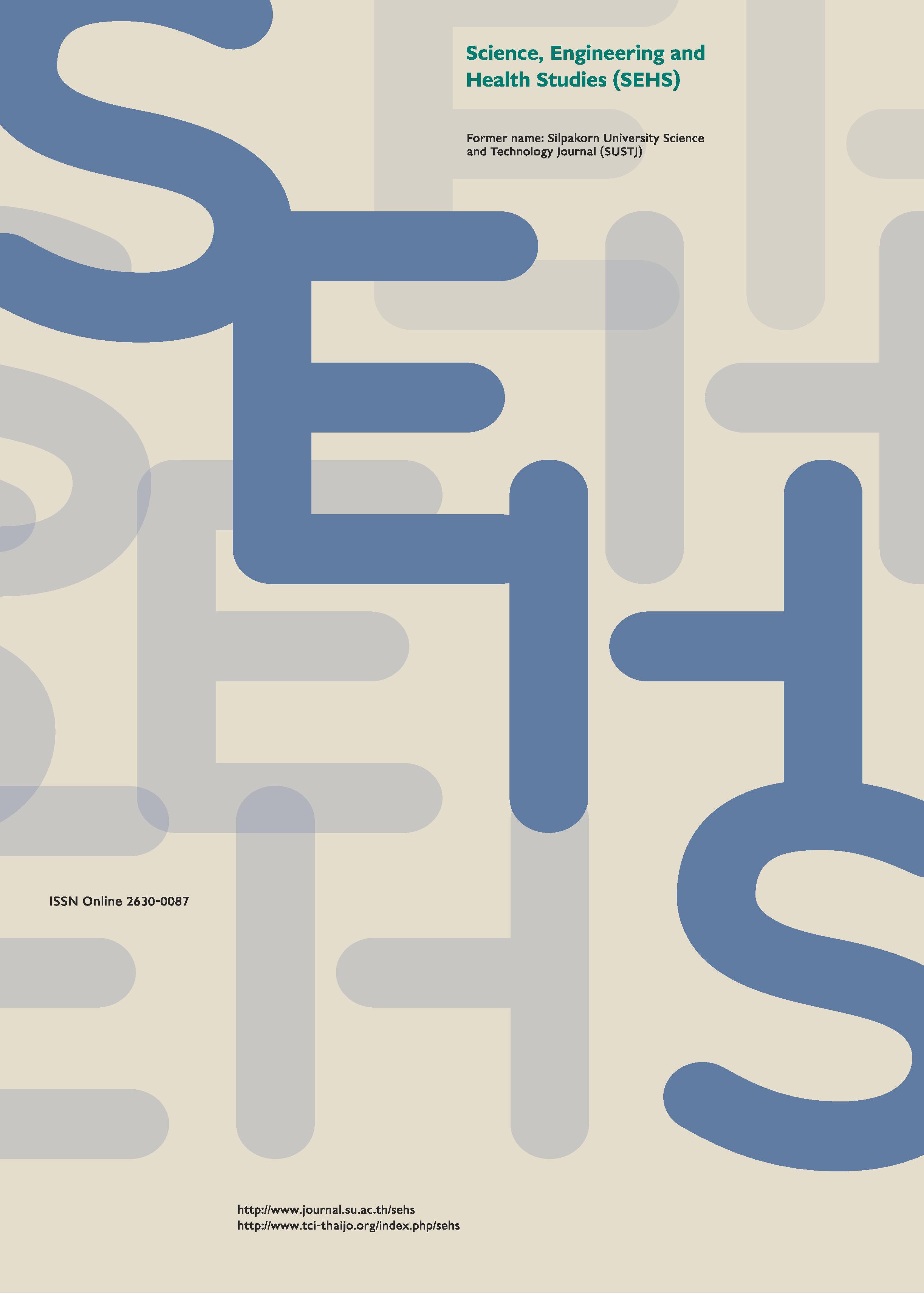Improvement of texture and gel stability of restructured frozen mango pulp by using xanthan gum and locust bean gum
Main Article Content
Abstract
Frozen restructured mango pulp (FRMP) is a form of preserved mango with a consistent texture and the ability to hold a definite shape. The objective of this study was to investigate the effect of xanthan gum (XG) combined with locust bean gum (LBG) on the textural properties, syneresis and sensory acceptance for FRMP from Nam Dok Mai variety and Ok Rong variety. Response surface methodology was employed for investigating the effect of XG (0.3 0.6%w/w) and LBG (0.2 0.6% w/w) on penetration force and syneresis of the FRMP samples. It was found that the relationship between these parameters could be fitted well to a first order linear model. Whilst both XG and LBG had a positive effect on the penetration force of the samples, a negative effect was observed for syneresis. Sensory evaluation using a 9 point hedonic scale indicated that the frozen restructured mango pulp containing 0.6% w/w XG and LBG received a significantly higher overall liking score than the sample containing 0.3% w/w XG and 0.2% w/w LBG, regardless of mango variety. Thus, there is a high potential for the application of XG LBG blends to the preservation of fresh mango pulp and other fruit pulps.
Downloads
Article Details
References
Arocas, A., Sanz, T. and Fiszman, S. M. (2009). Improving effect of xanthan and locust bean gums on the freeze thaw stability of white sauces made with different native starches. Food Hydrocolloids, 23, 2478-2484.
Caporaso, N., Genovese, A., Burke, R., Barry Ryan, C., and Sacchi, R. (2016). Effect of olive mill wastewater phenolic extract, whey protein isolate and xanthan gum on the behaviour of olive O/W emulsions using response surface methodology. Food Hydrocolloids, 61, 66-76.
Chivero, P., Gohtani, S., Yoshii, H., and Nakamura, A. (2015). Effect of xanthan and guar gums on the formation and stability of soy soluble polysaccharide oil in water emulsions. Food Research International, 70, 7-14.
Copetti, G., Grassi, M., Lapasin, R., and Pricl, S. (1997). Synergistic gelation of xanthan gum with locust bean gum: a rheological investigation. Glycoconjugate Journal, 14, 951-961.
Dumitriu, S. (1998). Polysaccharides Structural Diversity and Functional Versatility. London: Marcel Dekker, Inc., pp. 913.
Dunstan, D. E., Chen, Y., Liao, M. L., Salvatore, R., Boger, D. V., and Prica, M. (2001). Structure and rheology of the κ-carrageenan/locust bean gum gels. Food Hydrocolloids, 15, 475-484.
Philliips, G. O., and Williams, P. A. (2009). Handbook of Hydrocollloids. Boca Raton: CRC Press, pp. 924.
Grizotto, R. K., Bruns, R. E., De Aguirre, J. M., and De Menezes, H. C. (2007). Technological aspects for restructuring concentrated pineapple pulp. LWT Food Science and Technology, 40, 759-765.
Harris, P. (1990). Food Gel. London: Elsevier Science Publishers Ltd., pp. 476.
Heymann, H., and Lawless, H. T. (2013). Sensory Evaluation of Food: Principles and Practices. USA: Springer.
Higiro, J., Herald, T. J., and Alavi, S. (2006). Rheological study of xanthan and locust bean gum interaction in dilute solution. Food Research International, 39, 165-175.
Khouryieh, H., Puli, G., Williams, K., and Aramouni, F. (2015). Effects of xanthan–locust bean gum mixtures on the physicochemical properties and oxidative stability of whey protein stabilised oil in water emulsions. Food Chemistry, 167, 340-348.
Khouryieh, H. A., Aramouni, F. M., and Herald, T. J. (2005). Physical, chemical and sensory properties of sugar free jelly. Journal of Food Quality, 28, 179-190.
Ledeker, C. N., Suwonsichon, S., Chambers, D. H., and Adhikari, K. (2014). Comparison of sensory attributes in fresh mangoes and heat treated mango purées prepared from Thai cultivars. LWT Food Science and Technology, 56, 138-144.
Mirhosseini, H., Tan, C. P., Taherian, A. R., and Boo, H. C. (2009). Modeling the physicochemical properties of orange beverage emulsion as function of main emulsion components using response surface methodology. Carbohydrate Polymers, 75, 512-520.
Moore, S. (2015). Rosa's Thai Cafe: The Cookbook. London: Octopus Publishing Group.
Morris, E. R. (1990). Mixed Polymer Gels. Great Yarmouth: Elsevier Science Publishers Ltd., pp. 476.
Morris, E. R. (2009). Functional interactions in gelling biopolymer mixtures. In: Modern Biopolymer Science (Kasapis, S., Norton, I. T., and Ubbink, J. B., eds.), pp. 167-198. San Diego: Academic Press.
Mouquet, C., Dumas, J. C., and Guilbert, S. (1992). Texturization of sweetened mango pulp: Optimization using response surface methodology. Journal of Food Science, 57, 1395-1400.
Nussinovitch, A., and Hirashima, M. (2014). Cooking Innovations using Hydrocolloids for Thickening, Gelling, and Emulsification. Boca Raton: CRC Press, pp. 314.
Rao, M. A. (1999). Rheology of Fluid and Semisolid Foods Principle and Applications. New York: Aspen Publishers, pp. 461.
Renou, F., Petibon, O., Malhiac, C., and Grisel, M. (2013). Effect of xanthan structure on its interaction with locust bean gum: Toward prediction of rheological properties. Food Hydrocolloids, 32, 331-340.
Sandolo, C., Bulone, D., Mangione, M. R., Margheritelli, S., Di Meo, C., Alhaique, F., Matricardi, P., and Coviello, T. (2010). Synergistic interaction of locust bean gum and xanthan investigated by rheology and light scattering. Carbohydrate Polymers, 82, 733-741.
Sousa, A. M. M., and Gonçalves, M. P. (2015). The influence of locust bean gum on native and alkali modified agar gels. Food Hydrocolloids, 44, 461-470.
Suwonsichon, S., Chambers Iv, E., Kongpensook, V., and Oupadissakoon, C. (2012). Sensory lexicon for mango as affected by cultivars and stages of ripeness. Journal of Sensory Studies, 27, 148-160.
Williams, P. A., and Phillips, G. O. (2010). Gum and Stabilisers for the Food Industry. Cambridge: RSC Publisher, pp. 325.
Zhan, D. F., Ridout, M. J., Brownsey, G. J., and Morris, V. J. (1993). Xanthan locust bean gum interactions and gelation. Carbohydrate Polymers, 21, 53-58.


